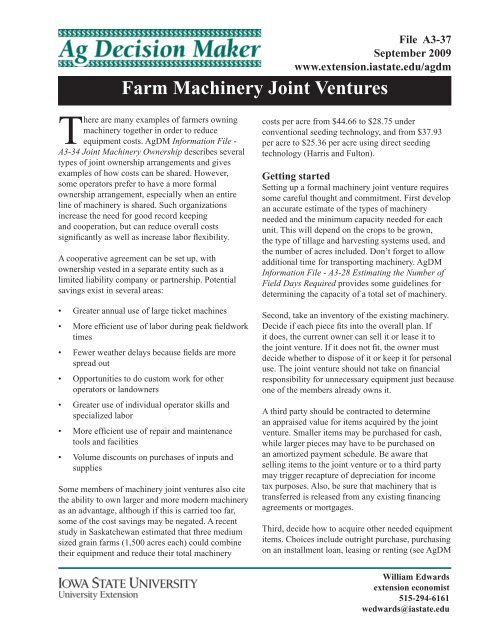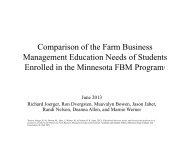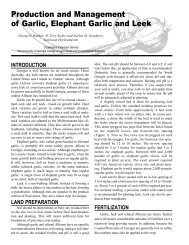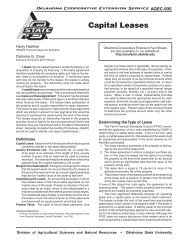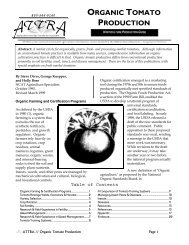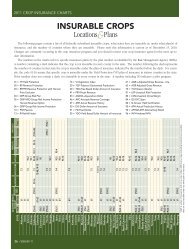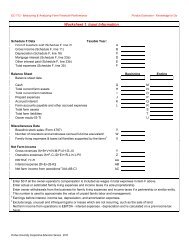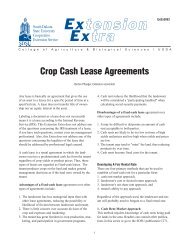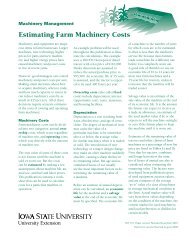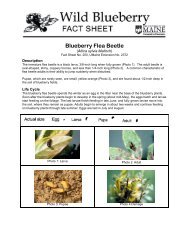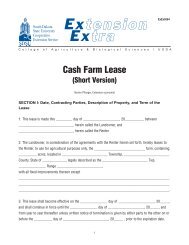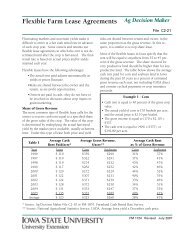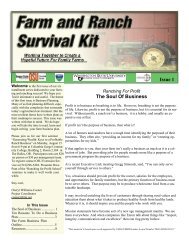A3-37 Farm Machinery Joint Ventures.indd - Iowa State University ...
A3-37 Farm Machinery Joint Ventures.indd - Iowa State University ...
A3-37 Farm Machinery Joint Ventures.indd - Iowa State University ...
Create successful ePaper yourself
Turn your PDF publications into a flip-book with our unique Google optimized e-Paper software.
File <strong>A3</strong>-<strong>37</strong><br />
September 2009<br />
www.extension.iastate.edu/agdm<br />
<strong>Farm</strong> <strong>Machinery</strong> <strong>Joint</strong> <strong>Ventures</strong><br />
There are many examples of farmers owning<br />
machinery together in order to reduce<br />
equipment costs. AgDM Information File -<br />
<strong>A3</strong>-34 <strong>Joint</strong> <strong>Machinery</strong> Ownership describes several<br />
types of joint ownership arrangements and gives<br />
examples of how costs can be shared. However,<br />
some operators prefer to have a more formal<br />
ownership arrangement, especially when an entire<br />
line of machinery is shared. Such organizations<br />
increase the need for good record keeping<br />
and cooperation, but can reduce overall costs<br />
significantly as well as increase labor flexibility.<br />
A cooperative agreement can be set up, with<br />
ownership vested in a separate entity such as a<br />
limited liability company or partnership. Potential<br />
savings exist in several areas:<br />
• Greater annual use of large ticket machines<br />
• More efficient use of labor during peak fieldwork<br />
times<br />
• Fewer weather delays because fields are more<br />
spread out<br />
• Opportunities to do custom work for other<br />
operators or landowners<br />
• Greater use of individual operator skills and<br />
specialized labor<br />
• More efficient use of repair and maintenance<br />
tools and facilities<br />
• Volume discounts on purchases of inputs and<br />
supplies<br />
Some members of machinery joint ventures also cite<br />
the ability to own larger and more modern machinery<br />
as an advantage, although if this is carried too far,<br />
some of the cost savings may be negated. A recent<br />
study in Saskatchewan estimated that three medium<br />
sized grain farms (1,500 acres each) could combine<br />
their equipment and reduce their total machinery<br />
costs per acre from $44.66 to $28.75 under<br />
conventional seeding technology, and from $<strong>37</strong>.93<br />
per acre to $25.36 per acre using direct seeding<br />
technology (Harris and Fulton).<br />
Getting started<br />
Setting up a formal machinery joint venture requires<br />
some careful thought and commitment. First develop<br />
an accurate estimate of the types of machinery<br />
needed and the minimum capacity needed for each<br />
unit. This will depend on the crops to be grown,<br />
the type of tillage and harvesting systems used, and<br />
the number of acres included. Don’t forget to allow<br />
additional time for transporting machinery. AgDM<br />
Information File - <strong>A3</strong>-28 Estimating the Number of<br />
Field Days Required provides some guidelines for<br />
determining the capacity of a total set of machinery.<br />
Second, take an inventory of the existing machinery.<br />
Decide if each piece fits into the overall plan. If<br />
it does, the current owner can sell it or lease it to<br />
the joint venture. If it does not fit, the owner must<br />
decide whether to dispose of it or keep it for personal<br />
use. The joint venture should not take on financial<br />
responsibility for unnecessary equipment just because<br />
one of the members already owns it.<br />
A third party should be contracted to determine<br />
an appraised value for items acquired by the joint<br />
venture. Smaller items may be purchased for cash,<br />
while larger pieces may have to be purchased on<br />
an amortized payment schedule. Be aware that<br />
selling items to the joint venture or to a third party<br />
may trigger recapture of depreciation for income<br />
tax purposes. Also, be sure that machinery that is<br />
transferred is released from any existing financing<br />
agreements or mortgages.<br />
Third, decide how to acquire other needed equipment<br />
items. Choices include outright purchase, purchasing<br />
on an installment loan, leasing or renting (see AgDM<br />
William Edwards<br />
extension economist<br />
515-294-6161<br />
wedwards@iastate.edu
Page 2 File <strong>A3</strong>-<strong>37</strong><br />
Information File - <strong>A3</strong>-21 Acquiring <strong>Farm</strong> <strong>Machinery</strong><br />
Services for comparisons). Choices regarding brand<br />
and dealer must also be made. Finally, a fund for<br />
paying operating expenses must be established.<br />
Each member may be required to contribute an<br />
equal amount of capital, or a fixed value per acre of<br />
cropland.<br />
Operations<br />
If each member uses the machinery only on his or<br />
her own acres, and provides all the labor for those<br />
acres, it is probably not necessary to keep a record<br />
of the hours contributed. However, one benefit of a<br />
joint venture is that two or more operators can work<br />
together, without regard to whose land it is, and<br />
complete operations more efficiently. If this is the<br />
case, each operator should keep track of the number<br />
of hours contributed. Having a logbook in each<br />
tractor, truck or self-propelled unit will make this<br />
easier. The value of each person’s labor can be used<br />
to offset his/her share of the expenses later. Some<br />
activities such as spraying or repairing machinery<br />
may be given a higher value per hour than other<br />
activities. Don’t forget to include time spent on<br />
maintenance, record keeping, travel, and group<br />
meetings.<br />
A quick and efficient process for deciding which<br />
acres will be covered each day must be established.<br />
Some groups appoint a “field boss” on a rotating<br />
basis. Others try to move from farm to farm<br />
geographically, then reverse directions the next<br />
season or crop. Regardless of what system is used,<br />
it must be flexible enough to take into account<br />
different rainfall patterns, soil types, and crop<br />
maturities.<br />
Cost accounting<br />
All costs associated with the ownership and<br />
operation of the machinery line should be paid<br />
by the joint venture, if possible. One exception<br />
may be fuel. If all operators fill all fuel tanks from<br />
their own reserves when the machinery leaves<br />
their property, then fuel costs can be excluded. If<br />
members occasionally pay small expenses from their<br />
own pockets, they should submit the receipts for<br />
reimbursement.<br />
At the end of the year all costs should be<br />
summarized and divided by the total number<br />
of acres farmed. This includes lease and rental<br />
payments, installment contract payments, repairs<br />
and maintenance, legal fees, insurance, licenses,<br />
fuel (if not furnished), lubricants and other items. A<br />
depreciation charge may be established instead of<br />
purchase contract payments. A charge for the cost<br />
of machinery storage space contributed by members<br />
may also be built in, unless this contribution is<br />
nearly equal or relative to acres farmed.<br />
Each member is billed according to his/her acres,<br />
after deducting the value of labor contributed by<br />
that member. If there is significant variation in the<br />
crops grown or the number of trips over different<br />
members’ fields, then charges can be allocated by<br />
the total hours spent on each member’s land instead.<br />
However, this would require some added record<br />
keeping.<br />
If trucking of grain is carried out by the machinery<br />
cooperative, and not everyone’s grain is sold at the<br />
same site, then a separate account should be set up<br />
for transportation. A log should be kept for each trip,<br />
including the number of bushels, number of miles<br />
hauled, and the owner(s) of the grain. At the end of<br />
the year, or when all of the crops have been sold,<br />
a cost per bushel-mile can be calculated and billed<br />
to each member according to his/her own usage. If<br />
income is earned by hauling grain for nonmembers,<br />
it can be subtracted from the total costs before<br />
they are allocated. AgDM Information File - <strong>A3</strong>-<br />
38, <strong>Farm</strong> <strong>Machinery</strong> <strong>Joint</strong> Venture Worksheet and<br />
Decision Tool <strong>A3</strong>-38 can be used to summarize and<br />
allocate expenses.<br />
Income tax treatment<br />
The exact handling of taxable income and expenses<br />
will depend on the type of legal entity selected. In<br />
general, though, the machinery cooperative will<br />
show income from the fees paid by the members<br />
for services, and deduct all the operating expenses,
File <strong>A3</strong>-<strong>37</strong><br />
Page 3<br />
interest, and depreciation associated with the<br />
machinery owned. Any profits or losses will be<br />
passed on to the members’ tax returns. Before<br />
forming a machinery cooperative, members need to<br />
realize that they will not be able to deduct Section<br />
179 expensing or other depreciation allowances<br />
on their own returns for equipment owned by the<br />
sharing entity. Moreover, they will probably have<br />
to recapture depreciation up to the value of any<br />
machinery that they sell to the cooperative or transfer<br />
as equity capital.<br />
Concerns<br />
Some of the most common concerns expressed by<br />
members of machinery ventures include:<br />
1. Need to schedule machinery use equitably when<br />
timing is critical to planting and harvesting.<br />
2. Lack of care by some members when using<br />
machinery, leading to excessive repairs and<br />
depreciation.<br />
3. Lack of flexibility in tillage, planting and<br />
harvesting systems when everyone is using the<br />
same set of machinery.<br />
4. Need to clean machinery between farms, to<br />
avoid commingling different types of grain or<br />
to prevent transporting weed seeds and insects.<br />
Removing trash and cans from the cab after<br />
each person uses a tractor or harvestor is also<br />
important.<br />
5. Need to have seed and chemicals available when<br />
fieldwork is to be done on each farm.<br />
6. Inability to use equity in the line of machinery<br />
as collateral for personal operating notes or other<br />
loans.<br />
Nevertheless, trust and good communication among<br />
members can usually overcome these potential<br />
problems.<br />
Case Study<br />
The Kiplinger Agricultural <strong>Machinery</strong><br />
Cooperative Ltd. (KAMCO) was formed in 1996,<br />
in Saskatchewan. Page 17 of <strong>Farm</strong> <strong>Machinery</strong><br />
Cooperatives in Saskatchewan and Quebec [http://<br />
www.usaskstudies.coop/pdf-files/Sask and PQ.pdf]<br />
includes a complete description of its organization<br />
and success.<br />
CUMAs<br />
<strong>Farm</strong> machinery joint ventures have been common<br />
in France and Quebec for many decades. They<br />
are known as “Cooperatives for the Utilization of<br />
Agricultural <strong>Machinery</strong>,” or CUMAs. At least 50<br />
CUMAs existed in Quebec in the year 2000, with<br />
more than a thousand members. While they are<br />
similar to the machinery joint ventures described<br />
so far in this module, they have some important<br />
differences, too.<br />
First, they tend to include more, but smaller,<br />
farming operations. This is typical of the smallscale<br />
livestock and forage farms that are common in<br />
eastern Canada. Second, members can join “activity<br />
branches.” Membership in an activity branch entitles<br />
an operator to the use of a particular machine rather<br />
than an entire line of equipment. Each member must<br />
commit to a membership period of three to five<br />
years, which matches the term of the installment<br />
contract under which the machine is being<br />
purchased. Each member also contributes an equal<br />
share of equity capital to finance the down payment.<br />
Membership fees cover the financing payments and<br />
operating costs, and are assessed in proportion to<br />
each member’s usage of the machine.<br />
CUMAs are organized according to traditional<br />
cooperative principles. Some CUMAs have extended<br />
the sharing concept to supplying fill-in laborers<br />
when a member must be away from home. For more<br />
information on CUMAs in Quebec and Ontario, and<br />
three case studies see The CUMA <strong>Farm</strong> <strong>Machinery</strong><br />
Cooperatives [http://www.usaskstudies.coop/pdffi<br />
les/CUMA fi nal.pdf].<br />
Summary<br />
<strong>Joint</strong> ownership of farm machinery offers medium<br />
and small operators a chance to reduce costs per<br />
acre and increase labor efficiency. However, some<br />
flexibility and independence may be sacrificed. <strong>Joint</strong><br />
ownership may be an informal agreement between
Page 4 File <strong>A3</strong>-<strong>37</strong><br />
two persons or a formal legal entity with a larger<br />
membership.<br />
However machinery is jointly owned, good records<br />
of ownership shares, costs paid, and all other facts<br />
are necessary for business and tax purposes. All<br />
parties should have a written agreement that explains<br />
how the machinery was acquired, and how the joint<br />
ownership will be dissolved in case of termination.<br />
The agreement also should explain how to determine<br />
the value of the machinery at the time of dissolution.<br />
References<br />
Artz, Georgeanne, William Edwards, and Frayne<br />
Olson. “<strong>Farm</strong> <strong>Machinery</strong> & Labor Sharing Manual.”<br />
Midwest Plan Service, NCFMEC-21. 2009.<br />
[http://www.mwps.org/]<br />
Harris, Andrea, and Murray Fulton. “<strong>Farm</strong><br />
<strong>Machinery</strong> Co-operatives in Saskatchewan and<br />
Quebec.” Center for the Study of Cooperatives,<br />
<strong>University</strong> of Saskatchewan, Saskatoon, SK. 2000.<br />
Harris, Andrea, and Murray Fulton. “<strong>Farm</strong><br />
<strong>Machinery</strong> Co-operatives: An Idea Worth Sharing.”<br />
Center for the Study of Cooperatives, <strong>University</strong> of<br />
Saskatchewan, Saskatoon, SK. 2000.<br />
Weness, Erlin. “Sharing <strong>Farm</strong> <strong>Machinery</strong>”<br />
<strong>University</strong> of Minnesota Extension Service. 2001.<br />
Weness, Erlin, and Jack Sperbeck. “Share <strong>Machinery</strong><br />
Ownership with Someone Far Away?” .” <strong>University</strong><br />
of Minnesota Extension Service. 2001.<br />
. . . and justice for all<br />
The U.S. Department of Agriculture (USDA) prohibits discrimination in<br />
all its programs and activities on the basis of race, color, national origin,<br />
gender, religion, age, disability, political beliefs, sexual orientation, and<br />
marital or family status. (Not all prohibited bases apply to all programs.)<br />
Many materials can be made available in alternative formats for ADA<br />
clients. To file a complaint of discrimination, write USDA, Office of<br />
Civil Rights, Room 326-W, Whitten Building, 14th and Independence<br />
Avenue, SW, Washington, DC 20250-9410 or call 202-720-5964.<br />
Issued in furtherance of Cooperative Extension work, Acts of May 8 and<br />
June 30, 1914, in cooperation with the U.S. Department of Agriculture.<br />
Jack M. Payne, director, Cooperative Extension Service, <strong>Iowa</strong> <strong>State</strong><br />
<strong>University</strong> of Science and Technology, Ames, <strong>Iowa</strong>.


